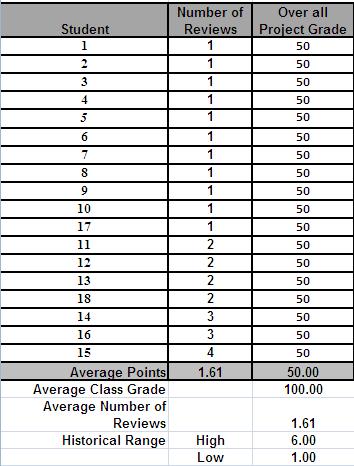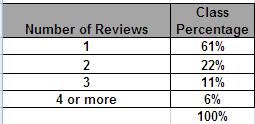

| DESIGNER | LEADER | LEARNER | MENTOR |
| LESSON PRACTICUM #1 | LESSON PRACTICUM #2 | UNIT PRACTICUM | ADVOCACY |
| Introduction/Overview Middle school keyboarding is a 6th grade, Career and Technology Education (CTE) course. It is the students’ first business class. It is an 18 week semester course with goals focusing on student improvement in technique, accuracy and speed. In my class, I focus heavily on projects which encompass a wide variety of authentic problems (e.g. small business owner, advertisement writer, magazine designer, graphics designer) for the students to complete. I offer a total of 12 total projects during the course (e.g. business cards, resume, advertisements, business letters, and career research). Macro demographics high lights of the school and county include: Farmwell Station Middle school is a Loudoun County Public School of roughly 1300 students, including 478 6th graders. The demographic data is presented in the following charts. For 2012, additional Farmwell student profiles can be found here.
Other data areas of note about the population of Loudoun County, as a whole, include: 1) It is the fastest growing county in the country over the past 10 years; 2) It has consistently been one of the most affluent counties in the United States, earning the “richest county in the United States” several years running with an average household income of $119,000 (2012); 3) the Median price for homes is $525K, one of the highest in Virginia and in the top 10 for the country. Micro Demographics—for purposes of this lesson practicum, each will stratify the specific or micro breakdown of each class for analysis, categories of race, general education, special education and English as a Second Language or (ESL) data points. As the following graphic illustrates, this class is racially and educationally diverse.  I. Lesson Goals From a broad perspective, the lesson goals for the lesson under study are to help students think about where their ancestors emigrated from, along with foods and family traditions that the students may have. This project is presented in a research format with an emphasis on following directions. The instructional goals include: student background and traits/traditions; I want the students to learn: 1) Self discovery of family background (country of origin, special traits, traditions and favorite foods—preferably from their ancestry; 2) research skills; 3) direction following—written AND oral; 4) presentation skills; and 5) DEAPR and C-RAP. For a detailed description of the lesson project click here: Project Description. For details of the rubric used to grade this plan, click here: Rubric. In addition to my overt goals in teaching this lesson plan, my covert goals include: 1) I hope to have students develop an understanding their cultural diversity and background; 2) I hope students come to understand that the United States I, indeed, a melting pot of backgrounds and cultures; and 3) I hope students gain a greater understanding of their ancestral background. From the student’s perspective, they will hopefully be learning several covert or hidden goals, such as: learning note taking skills, interviewing, traits discovery, Internet searching/researching, and presentation skills (speaking, design concepts--DEAPR and C-RAP). The students have been exposed to ACTS, DEAPR, and C-RAP concepts throughout the quarter and their importance in the class from previous lessons and from the review process for this project. I am checking and reinforcing students’ understanding of these concepts. I will also be learning to provide timely and accurate feedback to students. I also hope to manage class processes effectively to the end product—the presentation, which captures the rubric information. I am checking and reinforcing my understanding of ACTS, C-RAP, and DEAPR and well. Instructional goals for students include listening, following directions and completing the various sections of the project description. For my learning—I am hoping to more effectively integrate AeCTS, C-RAP and DEAPR in this particular project. The expected outcomes are for students to produce a one page Word document answers to the four questions. The challenges here are twofold: First, students in the past have not grasped the concept that a country is not a state. Several students list Pennsylvania and think it is a country; Second, since there is no “official homework,” if students do not know their backgrounds, they must remember to get information from parents at home. Getting them to ask parents several of the questions, effectively interviewing them and taking notes on the discussion can prove difficult and could delay the project. I will know student learning has occurred from several sources as per the practicum set up. Quantitative and qualitative parameters will be used. For this project, the rubric will be used to assess students’ Word presentation (see previous link). From an instructional point of view, I will be scaffolding additional content and will teach it in the form of model, coach, and fade. I will be doing a complete project example in front of the class. From a tools perspective, I will be using verbal feedback and project reviews to check for compliance with the rubric. I will be keeping a teacher journal to capture notes to indicate my impact on student learning. I will also be how many “review cycles” it takes to get the project compliant to the rubric. II. Quantitative Evidence of Student Learning   From a quantitative standpoint, there are several interesting numbers to note. First, the number of reviews and subsequent reviews was low, historically speaking. In previous years, most classes average three reviews per student. With this class, the average was 1.6. Second, the percentage chart on the right notes that over 61% got it perfect on the first required review, which is great. 34% had between 2-3 errors and only 6% had four, significantly lower that the “one review category.” Also, the highest here was four—previously it was six. Overall, each review yielded fewer and fewer mistakes so the students were “learning from their mistakes.” Taken as a whole, this suggests that there was a great deal of learning but it is inconclusive. III. Qualitative Evidence of Student Learning From my notes in the teacher journal, the exit questions demonstrated a high degree of learning based on the answers directly from students. These are sample responses from students on the three questions: Question
1: What did you learn?
“It was fun learning about my family and background. “ “I want to learn more about my grand. “ “Never really thought I was unique but do now.” “I would like to start some traditions.” “We are all unique but the same.” Question
2: What did you like about this lesson?
“This lesson was fun.” “Other culture and foods are interesting.” “Never thought about keyboarding and social studies but it was cool.” “Decorating and formatting for projects is fun.” Question 3: What changes would you make? “None. I love Mr. Stephenson’s projects. “ “I would make it easier—less reading. “ “I would like to do my own questions.” “Have it be two pages.” Interestingly, in previous classes, there was a great deal of confusion with students between states and countries--many picking states. In this lesson, the emphasis on the “model, coach and fade” paradigm, there seemed to be less of state/country confusion. I did not track the number but appeared lower. I usually have 3-4 but only had 1 in this class. Additionally, it reflects paying attention to the project description, student project managers helping other students--along with the teacher led lesson review—helped the class understanding the requirements more. Lastly, students seemed to have a fun positive experience. Several times in class, I would hear: “This castle looks cool,” “I would love to go here,” or “I did not know that about my home country.” Overall, the students genuinely had a positive experience blending keyboarding and social studies on this lesson. For this lesson, I have reverted back to my grading “do it right until it’s perfect.” Everyone gets an A.” Some students get it correct in one review, as noted. Others take longer. This reflects a process of improvement and mastery of the lesson requirements. Students seem to perform better because they want to get it right the first time. As I have said in class many times: “Get it wrong until you get it right. See the opportunity in failing. After all, do you want to be right the first time or wrong 6? It is your choice.” From my standpoint of teaching this project for over four years, the class performed very well. IV. Samples of Student Work I included 3 samples for review. One example is a general education student that performs very well in my class reading and following directions. With this student, he went through four review cycles to meet the requirements. When I asked why, he said he was just having an off day. He noted that my Model, Coach, and Fade did help but was just not “into it.” The second sample is a great story. It is from a special education student who seemed to really enjoy the project and learning about his family’s heritage. He only took one review to get it perfect. He was helped by one of the student Project Managers, which makes this even more poignant. The last project is from an ESL student that took slightly more than the class average to get everything correct. These results I found interesting: the general education student took the most reviews while the special education and ESL students took fewer. V. What Worked With this lesson plan, I am happy that more things went right than wrong. First, the Teacher Journal is yielding a great source of information in a real-time, note taking class environment. This helps to capture thoughts and comments quickly. Second, the student exit question exercise got me to think about my students learning likes, dislikes and areas for improvement. Leaving open ended questions as a post project survey was an excellent idea suggested by Dr. Norton. Third, the student helpers continually offer great suggestions for peers to accomplish the project. They really helped out in managing the classroom flow and off loaded the instructor to help with more detailed/difficult questions with other students. Fourth, I changed this lesson back to a self-paced, as opposed to full class. This enriched the learning environment for the students. As most, students groups 3, 5 or 7 were working on the project at any one time. Individual attention yielded more in depth questioning and learning—based on student responses and my observation of the classroom. Lastly, the Model, Coach, and Fade technique works extremely well in taking out confusion and initial level questions. Verbal and visual learners glean insight to the project requirements at a higher rate, as well—especially for those that have reading/comprehension difficulties. VI. What Would I Change/Modify To be perfectly frank, there are very view things I would modify in this lesson. That said, I would employ two changes: 1) Teacher journal; 2) Post Project student questions. VII. Lessons for Your Practice Model, Coach, and Fade will be the standard for introducing all projects. Period. Having employed it inconsistently over the past six years, it is a powerful tool for my designer tool bag. It is just the best approach and fits my teaching style very well. It produces a better learning experience with far less questions and classroom confusion. The Teacher Journal is something I will employ in my other projects and classes to continuously refine the progress and to get feedback from students. This will work particularly well with introducing new projects that are untested. It provides a way to go back and review notes and patterns to adjust for future classes. While a small addition to this lesson plan, I offered students a choice for responses (e.g. cultural foods vs. favorite foods). This helps special education and ESL students with an easier choice. It also offers me an exit strategy if a student has forgotten to ask his/her parents a particular question from the project description. Lastly, the exit questions will promote student participation in refining the project with ideas and checking to be sure the goals that the teacher have are transferred. Traditionally, this has been verbal in my class but this improves the process: it is not only a keyboarding exercise but a feedback mechanism for learning and suggested improvements. |